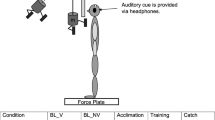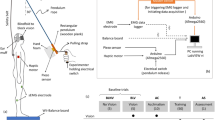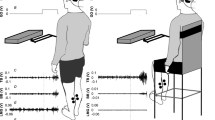Abstract
Recent experiments have shown that the vestibular channel of balance control differs fundamentally from the visual channel. Whereas the response to a visual perturbation can be suppressed if the subject has awareness that an upcoming disturbance is likely to be caused by an external agent rather than by self-motion, a similar assumption cannot be made concerning the vestibular system. The present experiment investigated whether postural responses evoked by a proprioceptive perturbation (vibration of the Achilles’ tendon at 90 Hz for 2.2 s) are either automatic and immune to expectation (similarly to vestibular responses) or cognitively penetrable (similarly to visual responses). Subjects (n = 12) stood on a force platform while stimuli were delivered either by the subject himself (self-triggered condition) or by the experimenter. For the latter condition, the stimulus was delivered either without warning (unpredictable condition) or at a fixed interval (500 ms) following an auditory cue (precue condition). Results showed that the backward CoP displacement induced by vibration was delayed by approximately 500 ms in the expected and self-triggered conditions compared to the unexpected condition. However, once initiated, the velocity of the backward displacement was higher in the self-triggered condition as compared to the unexpected condition. After a period of 2.2 s of vibration, the amplitude of this backward CoP displacement was similar in the three experimental conditions. Therefore, although expectation appears to delay the upcoming of the main backward body sway, it does not appear to be able to weight the impact of the proprioceptive stimulation. This suggested that afferents provided by the different sensory channels involved in postural control are not similarly susceptible to high level processes such as expectation.


Similar content being viewed by others
References
Adamcova N, Hlavacka F (2007) Modification of human postural responses to soleus muscle vibration by rotation of visual scene. Gait Posture 25:99–105
Aruin AS, Latash ML (1995) The role of motor action in anticipatory postural adjustments studied with self-induced and externally triggered perturbations Exp Brain Res 106:291–300
Aruin A, Mayka M, Shiratori T (2003) Could a motor action that has no direct relation to expected perturbation be associated with anticipatory postural adjustments in humans? Neurosci Lett 341:21–24
Blumle A, Maurer C, Schweigart G, Mergner T (2006) A cognitive intersensory interaction mechanism in human postural control. Exp Brain Res 173:357–363
Bouisset S, Zattara M (1987) Biomechanical study of the programming of anticipatory postural adjustments associated with voluntary movement. J Biomech 20:735–742
Bronstein AM (1986) Suppression of visually evoked postural responses. Exp Brain Res 63:655–658
Bronstein AM, Hood JD, Gresty MA, Panagi C (1990) Visual control of balance in cerebellar and parkinsonian syndromes. Brain 113:767–779
Day Bl, Guerraz M (2007) Feedforward versus feedback modulation of human vestibular-evoked balance responses by visual self-motion information. J Physiol 582:153–161
Diener HC, Horak F, Stelmach G, Guschlbauer B, Dichgans J (1991) Direction and amplitude precuing has no effect on automatic posture responses. Exp Brain Res 84:219–223
Dufosse M, Hugon M, Massion J (1985) Postural forearm changes induced by predictable in time or voluntary triggered unloading in man. Exp Brain Res 60:330–334
Ehrenfried T, Guerraz M, Thilo KV, Yardley L, Gresty MA (2003) Posture and mental task performance when viewing a moving visual field. Brain Res Cogn Brain Res 17:140–153
Fransson P, Johansson R, Hafstrom A, Magnusson M (2000) Methods for evaluation of postural control adaptation. Gait Posture 12:14–24
Fransson PA, Kristinsdottir EK, Hafstrom A, Magnusson M, Johansson R (2004) Balance control and adaptation during vibratory perturbations in middle-aged and elderly humans. Eur J Appl Physiol 91:595–603
Freitas Junior PB, Barela JA (2004) Postural control as a function of self- and object-motion perception. Neurosci Lett 369:64–68
Guerraz M, Day BL (2005) Expectation and the vestibular control of balance. J Cogn Neurosci 17:463–469
Guerraz M, Shallo-Hoffmann J, Yarrow K, Thilo KV, Bronstein AM, Gresty MA (2000) Visual control of postural orientation and equilibrium in congenital nystagmus. Invest Ophthalmol Vis Sci 41:3798–3804
Guerraz M, Gianna C, Burchill P, Gresty MA, Bronstein AM (2001a) Effect of visual surrounding motion on body sway in a 3 D environment. Percept Psychophys 63:47–58
Guerraz M, Thilo KV, Bronstein AM, Gresty MA (2001b) Influence of action and expectation on visual control of posture. Cogn Brain Res 11:259–266
Guerraz M, Yardley L, Bertholon P, Pollak L, Rudge P, Gresty MA, Bronstein AM (2001c) Visual vertigo: symptom assessment, spatial orientation and postural control. Brain 124:1646–1656
Hatzitaki V, Pavlou M, Bronstein AM (2004) The integration of multiple proprioceptive information: effect of ankle tendon vibration on postural responses to platform tilt. Exp Brain Res 154:345–354
Horak FB, Diener HC, Nashner LM (1989). Influence of central set on human postural responses. J Neurophysiol 62:841–853
Hunter MC, Hoffman MA (2001) Postural control: visual and cognitive manipulations. Gait Posture 13:41–48
Ivanenko YP, Talis VL, Kazennikov OV (1999) Support stability influences postural responses to muscle vibration in humans. Eur J Neurosci 11:647–654
Ivanenko YP, Solopova IA, Levik YS (2000) The direction of postural instability affects postural reactions to ankle muscle vibration in humans. Neurosci Lett 292:103–106
Lackner JB, Rabin E, Dizio P (2000) Fingertip contact suppresses the destabilizing influence of leg muscle vibration. J Neurophysiol 84:2217–2224
Lacquaniti F, Maioli C (1989) Adaptation to suppression of visual information during catching. J Neurosci 9:149–159
Lee DN, Lishman JR (1975) Visual proprioceptive control of stance. J Hum Mov Stud 1:87–95
Lestienne F, Schoechting JF, Berthoz A (1977) Postural readjustment induced by linear motion of visual scenes. Exp Brain Res 28:363–384
Maki BE, Whitelaw RS (1993) Influence of expectation and arousal on center-of-pressure responses to transient postural perturbations. J Vestib Res 3:25–39
Massion J (1992) Movement, posture and equilibrium: interaction and coordination. Prog Neurobiol 38:35–56
McChesney JW, Sveistrup H, Woollacott MH (1996) Influence of auditory precuing on automatic postural responses. Exp Brain Res 108:315–320
Mergner T, Schweigart G, Maurer C, Blümle A (2005) Human postural responses to motion of real and virtual visual environments under different support base conditions. Exp Brain Res 167:535–556
Nashner LM (1976) Adapting reflexes controlling the human posture. Exp Brain Res 26:59–72
Nashner LM, Black FO, Wall C (1982) Adaptation to altered support and visual conditions during stance: patients with vestibular deficits. J Neurosci 2:536–544
Nougier V, Teasdale N, Bard C, Fleury M (1999) Modulation of anticipatory postural adjustments in a reactive and a self-triggered mode in humans. Neurosci Lett 260:109–112
Pastor MA, Day BL, Marsden CD (1993) Vestibular induced postural responses in Parkinson’s disease. Brain 116:1177–1190
Polonyova A, Hlavacka F (2001) Human postural responses to different frequency vibrations of lower leg muscles. Physiol Res 50:405–410
Roll JP, Roll R (1988) From eye to foot: a proprioceptive chain involved in postural control. In: Amblard B, Berthoz A, Clarac F (eds) Posture and gait: development, adaptation and modulation. Elsevier, Amsterdam, pp 155–164
Roll R, Gilhodes JC, Roll JP, Popov K, Charade O (1998) Proprioceptive information processing in weightlessness. Exp Brain Res 122:393–402
Shumway-Cook A, Woollacott M, Kerns KA, Baldwin M (1997) The effects of two types of cognitive tasks on postural stability in older adults with and without a history of falls. J Gerontol A Biol Sci Med Sci 52:232–240
Smetanin BN, Popov KE, Kozhina GV (2002) Human postural responses to vibratory stimulation of calf Muscles under conditions of visual inversion. Hum Physiol 28:53–58
Valkovic P, Krafczyk S, Saling M, Benetin J, Botzel K (2005) Postural reactions to neck vibration in Parkinson’s disease. Mov Disord 21:59–65
Valkovic P, Krafczyk S, Botzel K (2006) Postural reactions to soleus muscle vibration in Parkinson’s disease: scaling deteriorates as disease progresses. Neurosci Lett 401:92–96
Vuillerme N, Nougier V, Teasdale (2000) Effects of a reaction time task on postural control in humans. Neurosci Lett 291:77–80
White KD, Post RB, Leibowitz HW (1980) Saccadic eye movements and body sway. Science 208:21–23
Acknowledgments
We thank Vincent Nougier for his guidance and help in the achievement of this work, Remy Cuisinier for expert technical assistance and BL Day for personnel communication. We also thank the reviewers for their valuable comments.
Author information
Authors and Affiliations
Corresponding author
Rights and permissions
About this article
Cite this article
Caudron, S., Boy, F., Forestier, N. et al. Influence of expectation on postural disturbance evoked by proprioceptive stimulation. Exp Brain Res 184, 53–59 (2008). https://doi.org/10.1007/s00221-007-1079-9
Received:
Accepted:
Published:
Issue Date:
DOI: https://doi.org/10.1007/s00221-007-1079-9




